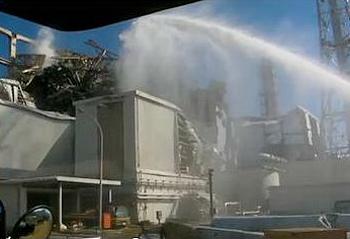
TOKYO, Japan, April 9, 2013 (ENS) – The Government of Japan has ordered Tokyo Electric Power Co. to fix fresh radioactive water leaks at its damaged Fukushima Daiichi nuclear power plant.
Leaks in three underground storage pits at Fukushima Daiichi have released an estimated 32,000 gallons of radioactive water since Friday, TEPCO officials report.
The underground tanks contain water that became radioactive when it was sprayed into the Fukushima Daiichi reactors continuously for months to cool the nuclear fuel after the earthquake and tsunami March 11, 2011 knocked out power to the power plant’s cooling system.

Three of the power plant’s six reactors suffered meltdowns anyway in the world’s worst nuclear accident since Chernobyl.
The three leaking tanks are among seven that TEPCO built to hold the radioactive water. The tanks all have two inner polyethylene linings and an outer clay lining.
Although radioactive cesium is removed before the water is moved to the tanks, other radioactive substances remain in the water. TEPCO confirmed that two of the tanks have been leaking the radioactive water this past week, the biggest leak since the early months after the 2011 disasters.
Today, a third tank was found to be leaking.
There also were several power outages that temporarily disabled the plant’s nuclear fuel cooling systems in March.
Economy, Trade and Industry Minister Toshimitsu Motegi today ordered TEPCO President Naomi Hirose to address public concerns about the radioactive water leaks and power outages.
In a meeting with Hirose, the minister instructed him to ensure that the radioactive water will not seep into the nearby Pacific Ocean.
TEPCO said Saturday on its website, “We assume that there is no leakage to the ocean since there is no drainage ditch near the reservoir.”
The Nuclear Regulation Authority summoned TEPCO Executive Vice President Zengo Aizawa today to discuss the leaks.
After the meeting, NRA Commissioner Toyoshi Fuketa said they are taking the incident seriously but assured the public that there is no cause for alarm at this time.
Fuketa said it will take some time before the contamination reaches the environment and says that by then, the company will have taken steps to contain the leaked water.
TEPCO continues to struggle with an enormous volume of contaminated water and an shortage of alternate space to store it.
Copyright Environment News Service (ENS) 2013. All rights reserved.
© 2013, Environment News Service. All rights reserved. Content may be quoted only with proper attribution and a direct link to the original article. Full reproduction is prohibited.
